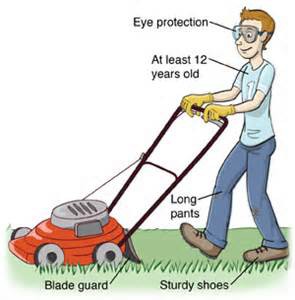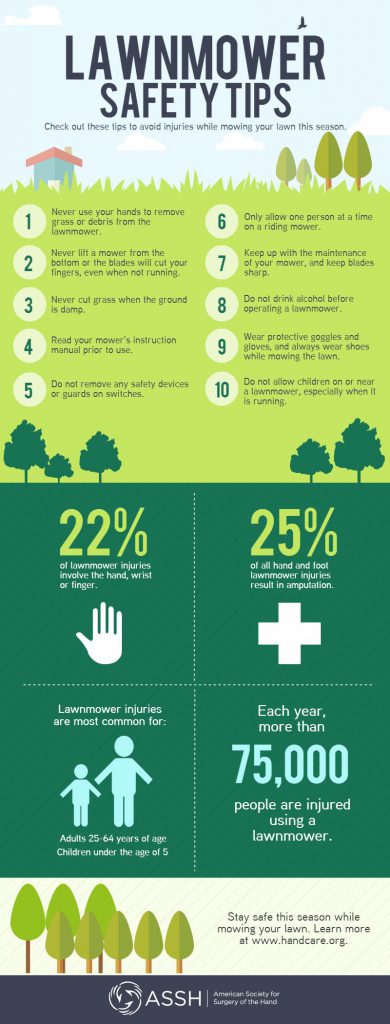Proper Lawn Mower Maintenance and Care
Maintenance Tips For Lawn Mowers
If you are a homeowner, you probably mow your lawn during the spring, summer and fall. Do you know what type of lawn mower maintenance and care that should be done to the mower when the mowing season is over? Do you know what you need to do to get your mower ready for the mowing season?
The objective of this article is to provide owners of lawn mowers with some specific maintenance tasks that should be done to their mower before the mowing season begins and after it ends. The tips below will cover electric; gas, battery, and manual push mowers.
Before The Mowing Season Begins Tips
Depending upon where you live, the time you begin should be up to you but, anytime before your grass needs to be mowed for the first time. In any case, read the owner’s manual to become familiar with the parts and the procedure to start the mower. This may vary depending upon the model purchased.
Before each mowing session, be sure to clean up the mowing area of debris, rocks, branches, and other potential flying objects, and clear the area of people and pets.
When mowing, dress appropriately whenever operating any lawn mower and this will include the following:
- Always wear substantial shoes or safety boots.
- Long pants and close-fitting clothes.
- Wear heavy work gloves to protect your hands when handling the blades and other items that might be sharp or have nicks or metal burrs on the edges.
- Safety glasses to protect eyes from potential flying objects.
Maintenance tips for gasoline models:
- Check your mower for any loose screws and bolts. Tighten any that are.
- Remove and replace the oil with the proper grade oil according to your owner’s manual.
- If you purchased a new mower, be sure the oil reads full on the dip stick. Add oil until it reaches the “full” mark. Do this before you start the mower for the first time.
- Before the start of the third mowing season, remove and replace the spark plug.
- Drain out the old gas and replace with fresh if you failed to perform this task in the fall.
- Dispose of all the old gas in the gas can and replace with fresh if not done in the fall.
- Check all filters and replace if they are dirty.
- Check to determine if the blades need sharpening.
- Add a fuel stabilizer to the gas to extend the freshness of the gas at every fill-up if gas is sitting for more than thirty days.
Maintenance tips for electric models:
- Check to determine if any screws or bolts are loose. Tighten any that are.
- If your model comes with an oil crankcase, remove the old oil and replace with new according to your owner’s manual.
- Check to determine if the blades need sharpening.
- Check the electric extension cord for any cracks or exposures. Dispose the cord if found and replace with a new one. This will prevent any shorts or electrical shocks.
- Lubricate the wheels.
Maintenance tips for battery powered models:
- Charge all batteries according to the instructions in the owner’s manual.
- Check the batteries for any cracks or exposures. Replace, if found.
- Remove the old oil from the crankcase and replace with fresh oil according to the specifications mentioned in the owner’s manual.
- Check to determine if the blades need sharpening.
- Lubricate the wheels.
Maintenance tips for manual push models:
- Lubricate the wheels and any movable parts. Follow the instructions in the owner’s manual.
- Check to determine if the blades need sharpening.
- Tighten any loose screws or bolts.
Maintenance tips for riding lawn mower models:
- Check oil levels before use.
- Check air filter for loose or damaged parts.
- Change engine oil after 10 hours.
- Replace air filter after 100 hours.
- Change spark plug after 100 hours.
- Lube pedal pivot points after 10 hours.
- Lube front axles and rims every 25 hours.
- Replace fuel filter after 100 hours.
- Clean engine cooling rims every 25 hours.
- Change, sharpen blades every 25 hours.
- Remove accumulations of grass, leaves, grease, oil and gas to reduce fire hazard.
- Watch for wear and damage on grass catcher parts and components.
- Add fuel stabilizer to fresh gasoline before adding it to your mower if the gas will be sitting unused for a period greater than thirty days.
After The Mowing Season Ends Tips
Here are some maintenance tips you should do at the end of the mowing season.
Gas models:
- Empty the old gas or run the machine until the engine dies.
- Tighten any loose screws or bolts.
- Clean the undercarriage by scraping off with a scrapper, putty knife, or wire brush any old grass, twigs and mud stuck to the surface.
- Store your mower.
- Replace the spark plug.
- Clean and inspect belts (replace warn or cracked belts.)
- Sharpen the blade.
- Change the oil.
- Change the oil filter if your unit has one.
- Dispose all the gasoline in the gas can in accordance with local ordinances.
Note: Some of these tips can be done prior to first use in the new mowing season.
Electric models:
- Tighten any loose screws or bolts.
- Check the extension cord for any cracks or exposures.
- Clean the underneath by scraping off any old grass, twigs and mud stuck to the surface.
- Store mower.
Battery models:
- Tighten any loose screws or bolts.
- Check the batteries for cracks or exposures. Replace if found.
- Store the batteries in a safe place.
- Clean the underneath by scraping off any old grass, twigs and mud stuck to the surface.
- Store the mower.
Manual push models:
- Tighten any loose screws or bolts.
- Lubricate areas that need it.
- Store mower.
Warranty Tips
If you bought a new mower, read the owner’s manual to determine what type of maintenance you are required to perform to keep the warranty active. Failure to perform the required maintenance will void the warranty. This is true regardless of the model purchased.
Conclusion
Another tip for all models except for push reel mowers, do not mow the grass whenever a person is close to the discharge chute as it can cause an injury. Wait for the person to be clear before proceeding.
By following the above tips, you can extend the life of your mower and give you great performance and keep you safe from injury or bystanders. Hopefully, these lawn mower maintenance tips have helped you to become an educated mower owner.
Go back to Snow Blowers and More home page.
Happy mowing!

